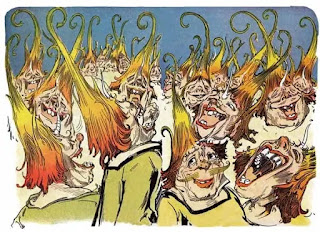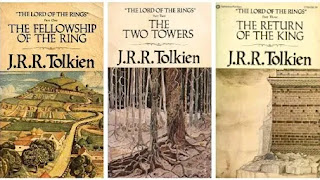Thanks to the both of you for doing this! How did you come to be involved with the project?Dariel: I've been working with editor/publisher Oliver Brackenbury since he launched the New Edge of Sword and Sorcery magazine, for the first several issues of which he solicited/commissioned most of the content. We got to meet through the recommendation of Ngo-Vinh Hoi in the Appendix N Book Club podcast; Hoi mentioned my collection, Swords of the Four Winds, among his recommendations, and that led to Oliver contacting me for an interview on his podcast, So I'm Writing a Novel.
At the end of that interview, he invited me over to the Whetstone Discord server. At around the time that I joined, a big discussion had started over what could be done to revitalize the sword and sorcery genre and get new readers in. That led to Brackenbury being tagged to edit and put up a new S&S zine, and I was among the writers who pitched in a story, gratis, for our Issue #0. Brackenbury Books has had several successful crowdfunders since then, lately for NESS 1 and 2 last year, 3 and 4 this year, and an anthology of S&S-meets romantasy, Beating Hearts and Battle Axes.
At around the same time NESS 3 and 4 were in production or planning, Oliver had already approached me on an idea to sort of revive the Ace Doubles or do a homage to the Ace Doubles.
Bryn: Like Dariel, I’d written for Oliver Brackenbury’s test issue of NESS, which was put out free in digital and at cost in physical formats. When NESS proved a success, we both went on to write further stories in further issues. There’s a New Edge Sword & Sorcery Discord server where I chat daily, and where Oliver, I guess, lays his evil schemes to expand in sword & sorcery publishing. I said a quick yes, of course, to his first ‘want to write a novella?
I think part of the appeal here is that two-in-one format that does remind fans of the Ace Doubles. So that was the publisher's idea? How do you feel about it?
Bryn: It was Oliver’s idea to put us back-to-back: two tales that kick off from the medieval Mongols and the great Mongol himself, Chinggis or Genghis Khan. Oliver got to know us, know our past work around Mongols, and thought it neat to have "steppe siblings" in a Double.
I think it works wonderfully well. Dariel and I have similarities, and we have contrasts too – you won’t feel it’s same-samey as you move from one novella to the other, since we have such different styles, but our stance, our position, the kind of thing we are concerned with, have a harmony and common ground.
We’re both set on the frontiers between the steppe of the nomads and settled societies, with the frontier issues that arose in history – and still arise today. Both of us take a nomad’s perspective on that history. Our heroes may be far apart as people, but each is very conscious – and fired up about! – the encroachment of settled civilizations onto the steppe, the creep of towns and cities into the free grass. I believe sword & sorcery is its most essential self when it sees from the less privileged point of view, which has often been the figure of the barbarian up against the ills of civilization. Both of us give what is resolutely a "nomad’s eye" on the world. If Goatskin and Orhan Timur met, they’d understand one another, they’d thrill to the same call. They’d be steppe brother and steppe sister, too.
In style, though, you get dishes quite distinct from one another. You won’t be bored. Dariel writes a strong, swift, propulsive story, and lists his influences as Robert E. Howard and David Gemmell: he has everything most classic about S&S, cast into a new sensibility for areas of Asia neglected in fantasy. Me, you can probably tell I’ve loved most a few fringes and odd edges of sword & sorcery, that I am attracted to the rich aesthetics of M. John Harrison’s Viriconium or Tanith Lee’s Tales from the Flat Earth. What excites me most about New Edge Sword & Sorcery and now Brackenbury Books is an openness to innovation within the genre.
Dariel: I loved all aspects of the doubles idea, of course, so I said yes, I don't think I even asked how much he was going to offer. But Oliver's very decent about that, he credits his parents, both freelance artists, with instilling in him an ethic of making sure creatives get paid their due, so it's a decent deal. Even better, I know from experience Oliver is good and active at promotion, so that level of attention I think makes working with a small press really worthwhile.
And doing a homage to the Ace Doubles of yore (haha, yeah, I feel old enough to say that!) is a special kick for me. I had quite a few of those, hunted for them in bargain bins all over the seamy side of downtown Manila and the old American airbase in Clark -- back in the 80s they were treasures, as prized as the DAW yellow spines. So given the chance to do that, and with Bryn's work as my novella's companion, it was a golden opportunity. I think Oliver's idea to do a 'steppe siblings' themed set for the first Double Edged book gave it a strong platform, and also fits very much what I want to do with S&S, which is to weave tales about and highlight what I call Forgotten Asia.
The project looks well on track to fund. What's next for you after that?
Dariel: I'm actually set to deliver two stories, because if we hit at least 250 backers all backers will receive my bonus story, The Shaman's Blood Price. That story is about Orhan and Jungar when they were still young and still brothers - kinda like an Obi Wan-Anakin teamup, and also features their first meeting with the villain of Walls, Qara Erke. As of 16:23 today, Manila time, we’re just thirty backers away from that. And we're already talking about another set of novellas for next year.
I also want to work on more Wali and Khalid stories. These are comical sword and sorcery stories patterned after the adventures of Sindbad. Khalid is dashing, handsome, brave as a lion, swift as a falcon...and thick as a city wall. Fortunately, he has Wali to do the thinking for him. Problem is, Wali is a lecherous failed sorcerer cursed with the body of a monkey! The Wali and Khalid stories are like palate cleansers for me, since I tend to write dark stories otherwise. I'll also be continuing work on my sword and planet novel Warrior of the Lost Age, and in between, tinkering with the Swords of Maruzar RPG and its setting.
Bryn: I hope we fund, because what comes next is highly exciting for me. Oliver has said in public that if this book works out, it’ll be the first of novella series for both characters, Dariel’s Orhan Timur the Snow Leopard and my Goatskin. I’m a slow writer so I am at work well ahead of time. Yesterday I sent Oliver a ten-page outline for the next novella, and today I wrote the first sentences. It has the working title What Rough Beast?, which I’m pretty committed to already.
Tell everybody where we can see more of your work.
Bryn: My website is
Amgalant. That’s mostly about my historical fiction on Chinggis/Genghis Khan, and the research for it. I have
a storefront where you can buy direct from me: my historical novels, my Voices from the Twelfth-Century Steppe, an essay on how to listen to the Secret History of the Mongols, my source, and a few short stories.
Dariel: For my self-published collections
Swords of the Four Winds and
Track of the Snow Leopard, there's
my Amazon page.


































.jpg)










